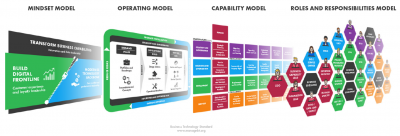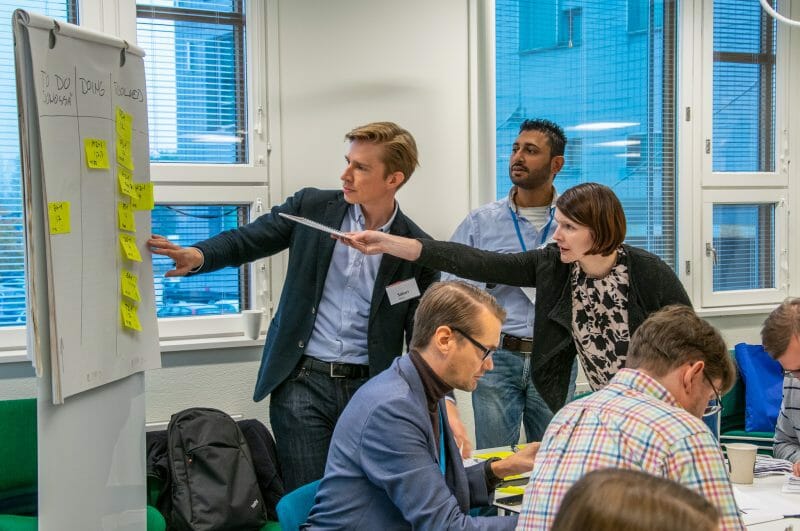A glimpse of our Business Technology standard
Today, business leaders look for speed and agility when developing new products, processes and services. The companies that lead with data, gain customer loyalty and balancing development and operational costs will provide a competitive edge that allows them to remain strong through disruptive and challenging times.
Many organizations will have to go through a significant cultural transformation as they need to become more agile in order to fully utilise the innovation potential created by digitalisation. This is not an easy task as existing systems, processes and ways of working need to co-exist together with new digital solutions.
The Business Technology Standard is a straight-forward and open-source management framework to plan, build and run information technology that delivers value to the business in today’s technology-driven business world.
The Business Technology Standard provides a thorough understanding of the overall technology management landscape. It provides best practices for end-to-end development of technology products, solutions and services, and helps to build the needed capability for managing digital transformation.
Developing new technology-enabled products, solutions and services quickly for the market has become a key success factor for every company, across all industries. Many organizations are, however, facing challenges combining traditional IT development with new digital development. Traditional IT management has difficulty keeping up with the pace that new digital development requires. In addition, digital development struggles to reach the required enterprise-level optimization and service management maturity for new digital services.
To address this, the Business Technology Standard provides clear guidance on how these two worlds fit together. It gives a comprehensive picture of how to manage the overall business technology organization, with pragmatic governance, and without compromising speed and agility. Using the Business Technology Standard on top of expert-level best practices such as SAFe and DevOps for agile development and ITIL for service management enables holistic management of different technology management functions.

Figure: Business Technology Standard perspectives
The Business Technology Standard consists of four complementary and consistent models and perspectives for unified information and digitalization management:
- Mindset model to define three dimensions: Transform business capabilities, build digital frontline and modernize technology backbone
- Operating model to define value creating flows and disciplines
- Capability model to define disciplines and associated capabilities
- Roles and responsibilities model to define identities, roles and responsibilities
The Operating Model defines how business value can be created with technology management. The operating model has five value adding disciplines: Demand, Development and Services, complemented with the two overarching disciplines: Strategy and Governance, and Sourcing and Optimization. Specifically, the operating model consists of Planning, Building and Running the value streams with a common strategy, governance, sourcing and optimization.
The Business Technology Standard introduces several unique elements addressing the current challenges many organizations are facing with digital development such as:
- Value streams to cope with business diversity and differences in speed, agility and culture
- Minimum viable governance to balance flexibility and governance in decision-making
- Multi-speed development flows to respect development method differences
- Unified roles to clarify the roles and responsibilities in a unified way
The Business Technology Standard defines gate-based and sprint-based development flows and four sources of demand:
- Capability planning to develop major business capabilities
- Ideas and concepts to generate ideas and challenge the status quo
- Increments and improvements to uplift/enhance existing business solutions or capability
- Service changes to continual service improvement
The Business Technology Standard serves the needs of many kinds of organizations. Organizations implementing and running pure agile methodology will benefit from the simplicity and clarity the Business Technology Standard provides. As not all services and solutions are optimal for sprint-based development, the Business Technology Standard provides the possibility to use different approaches without compromising the agile culture. In addition, the Business Technology Standard proposes a consistent and systematic approach in service management for agile-minded companies.
Organizations that are using traditional gate-based development and process-driven service management can utilize the Business Technology Standard to broaden the methodologies they use towards agile and DevOps types of development practices. Overall, the Business Technology Standard aims to challenge the status quo and inspire organizations to continuously search for more pragmatic, innovative and value-creating development and management practices.
The Business Technology Standard has been continuously co-developed and renewed during the past ten years, in a collaboration of hundreds of stakeholders from global companies and public organizations throughout the Nordics. It is recognized today as one of the leading best practices. It has proven to work well for real business use especially because of its clarity, consistency and simplicity. The just-released fourth version follows the same foundation but has been fully rewritten and renewed to respond to the IT and digitalization management challenges of the 2020s, and the scope of technology management has been extended from information technology to business technology.
Unlike many other methodologies, the Business Technology Standard is available as an open-source provided by a non-profit community, called the Business Technology Forum, for the benefit of the entire information technology society. The Business Technology Standard is constantly renewed and developed in close cooperation with several global companies and organizations, ensuring that it is up-to-date and in alignment with the latest real-life challenges. The Business Technology Forum runs several development sprints per year and publishes two releases annually.
The Business Technology Standard is compliant with the most popular expert-level global best practices such as SAFe, DevOps, IT4IT and ITIL. Irrespective of the use of other standards, the Business Technology Standard provides the bigger picture and clarity for managing IT and digital transformation. Find our newest standard here.


